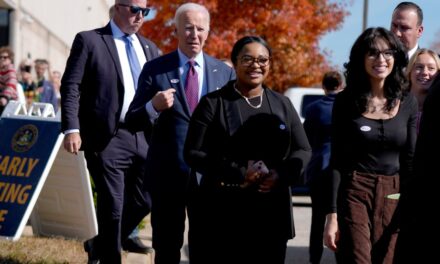
Like many good children’s stories, Next Year in the White House features colorful illustrations, young protagonists and a furry four-legged friend.
But why is this children’s book different from all other children’s books?
Those characters are the daughters and the dog of President Barack Obama, and this story begins with them walking around a table set elaborately for a Passover Seder. It was 2009, and Sasha and Malia Obama were about to join their famous father — and their famous dog, Bo — for the first official Passover celebration in White House history.
The book, published by Penguin Random House this spring and distributed by the Jewish literacy nonprofit PJ Library, begins with the story of that first White House Seder. But most of the book describes the Seder that took place a year earlier on the campaign trail, at a low point for Obama, when the refrain “Next year in the White House” felt as realistic as the prophet Elijah actually walking, in the flesh, through the front door at the end of the Seder.
“It’s a feel-good story,” said Eric Lesser, who organized the 2008 campaign Seder in Harrisburg, Pa. Lesser, at the time a recent college graduate, was the person who schlepped Obama’s luggage everywhere. “It’s a story about bringing people, especially different people from different backgrounds and different faith traditions, together. There’s a degree to which it almost feels like escapism from the current moment, especially for the Jewish community that’s been facing such trauma and violence in the last year and a half.”
The book was written by Richard Michelson, a children’s book author and poet, and illustrated by E.B. Lewis. But the impetus for the book came from Lesser, a lawyer who lives in the same Western Massachusetts community as Harold Grinspoon, the founder of PJ Library.
“We go to the same synagogue and live very close to each other. And I remember one day I just mentioned to him the idea that had been presented to me about a children’s book, and he loved the idea,” Lesser told Jewish Insider. Lesser didn’t hear anything about it for a long time. “Then kind of out of the blue, [Grinspoon] called me one day and said, ‘PJ Library wants to turn this into a book.’ And the rest is history.”
The story of that 2008 campaign Seder is the stuff of legend, passed around in Jewish Democratic circles in Washington for years. Now, this book makes the case that it should be told to the next generation of American Jews around the country.

Back then, Lesser, Herbie Ziskend and Arun Chaudhary — all junior campaign staffers at the time — gathered in a hotel room in Harrisburg for an ad hoc Seder, with Manischewitz, matzah, macaroons and Maxwell House Haggadot that Lesser’s cousin brought to them on the campaign trail. They did not anticipate any other attendees, until Obama knocked on the door and asked to join them.
“I remember we were going around, and Obama was very attentive and intentional about doing it and understanding what everything meant,” said Lesser.
The book, geared toward second graders, tells the story of that 2008 Seder while also sharing the story of Passover — the Jews’ slavery in Egypt and then their exodus from bondage. “Barack reflected that it was enslaved Black laborers who laid the logs and stones for America’s White House,” the book states.
A year later, Obama was president. Lesser, Ziskend and Chaudhary still worked for him. None of them considered they would be celebrating Passover in the White House, until one day when Obama walked by Lesser’s desk.
“Obama turned to me and he said, ‘Hey, Lesser, are we doing the Seder this year?’ And I kind of jumped up and said, ‘I don’t know, sir, are we?’ And he said, ‘Well, last year, I said, next year in the White House, and it’s next year, and we’re in the White House,’” Lesser recalled. Obama wanted to do it again with the same group that had been with him on the campaign trail.
Over the eight years that Obama was in the White House, that same core group came together each spring. (One year they even used a Seder plate gifted by Israeli Prime Minister Benjamin Netanyahu.) The young campaign staffers got married and brought their wives. They brought their grandparents. A photo showing Lesser’s grandmother at the first White House Seder was in the newspaper in 2009, and his aunt brought it to her in her retirement community in Brooklyn.
“My grandmother, who had lived through a lot by that point, looked at the picture and, looked at my aunt, and basically said, ‘Only in America could something like this happen,’ meaning a Jewish family being in the White House celebrating a Passover so openly like that,” said Lesser. “I think it’s an important feeling to hold on to, especially now.”
Other leaders have followed Obama’s lead in celebrating Passover, but not with the same consistency. Vice President Kamala Harris hosted a Seder at the Naval Observatory in 2022, planned by Ziskend, who was by then working for her.
The story ends with a scene familiar to any Jewish family: two young kids, impatient, eager to search for the Afikomen as the grown-ups keep talking. Their prize for finding the Afikomen? A new chew toy for Bo.
“I think that it was really a landmark moment in Jewish American history to have the president of the United States, the highest level of the U.S. government, recognize a Jewish tradition in this way,” said Ziskend. “It connected to the broader story that makes the Passover story resonate, that this is a tale of liberation, of freedom and resilience, and that you had an American president, the first Black president, telling that story to his daughters. It was just a very powerful moment in time and moment in history.”




